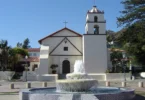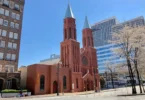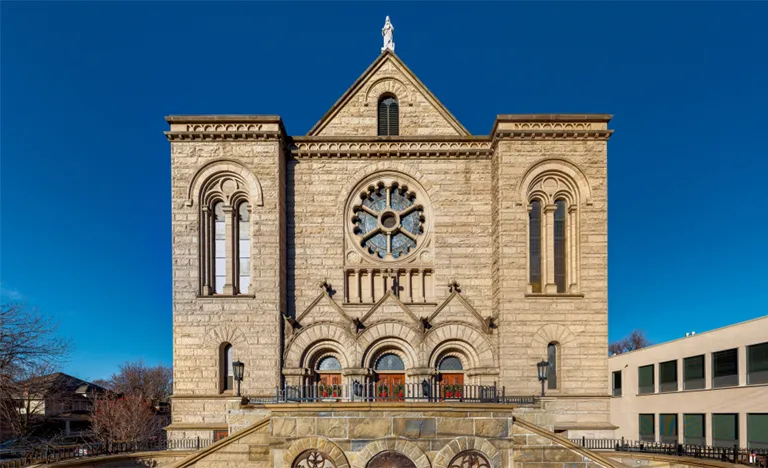
Introduction
The Cathedral of Saint John the Evangelist, Boise also known simply as St. John’s Cathedral, is a Catholic cathedral and parish church located in Boise, Idaho, United States. It is the seat of the Diocese of Boise.
A decade and a half after Idaho’s 1890 statehood, Boise’s rapid growth necessitated an increase of civic buildings in the state’s capital city. During this period, Idaho’s premier architectural firm began work on two large institutional buildings that forged the city’s image as government and cultural center: the State Capitol Building in 1905 and the Cathedral of St. John’s in 1906.
As the most visible symbol for the Catholic Diocese of Idaho, the cathedral is a spiritual counterbalance to the secular, classical capitol building visible a few blocks south. The Romanesque Revival cathedral is a concert of stained glass, light, color, rare materials, and ornament that celebrates the strength of the Catholic faith.
In 1893 Boise’s Catholic population reached 7,000 warranting diocesan status. Bishop Glorieux established the Diocese of Boise under Pope Leo XIII, and “envisioned a cathedral dedicated to St. John the Evangelist.” When funds were secured, he hired parishioner Charles F. Hummel of Tourtellotte and Hummel to design the cathedral.
The Cathedral of cornerstone was laid in 1906 and construction continued in stages over a fifteen year period. With no alternative place to worship, mass continued to be held within the partially completed cathedral throughout construction, allowing the Diocese to stay solvent and avoid incurring debt. Bishop Glorieux died in 1917 and his successor, Bishop Daniel Gorman, more comfortable with debt, accelerated the cathedral’s completion.
The church is constructed of local sandstone from the nearby Table Rock Quarry. Hummel based his design on the Romanesque Cathedral of Mainz in Germany, where he grew up, as well as St. Sernin in Toulouse, France, as a secondary source of inspiration. The design, as first presented, included a pair of towers making the church appear tall and slender. Because the towers were never completed, the cathedral has a bulkier appearance not unsuitable for its Romanesque Revival styling.
The church’s large and blocky sandstone exterior and its first-story Romanesque entry arches establish the church’s character. The stonework is left rough with refined ashlar joinery and finely cut upper window trefoil ornament. The front facade’s focal point is a large twelve-foot rose window articulated by six spokes. The window ensemble rests on nine equally spaced Tuscan columns set within a false recessed window.
On the interior, the rose window, which illuminates the upper choir, reveals itself more clearly as a stained glass window depicting Saint Cecilia, patron saint of musicians, who is surrounded by six angels playing musical instruments. On the exterior the window assembly floats above three repeating Romanesque arched entries. Above the window rises the main roof center gable with Saint John the Evangelist at its peak.
The church building was individually listed on the National Register of Historic Places in 1978.
It was included as a contributing property of the St. John’s Cathedral Block when the rest of the parish buildings on Block 90 were added to the National Register in 1982. That same year, the parish buildings were included as a contributing property in the Fort Street Historic District.
History of Cathedral of Saint John the Evangelist, Boise
Cathedral of Saint John the Evangelist, Boise was the dream of Bishop Alphonse Glorieux, under whose direction it was built. In 1884 Father Glorieux, the President of St. Michael’s College in Portland, was appointed Bishop of the newly created Vicar Apostolic of Idaho, for which Boise City was the seat. At that time, only two priests served the entire Idaho territory with its 1500 parishioners.
Within less than ten years, under Bishop Glorieux’s guidance, the Vicariate grew to a population of 7,000 Catholics, with ten Priests, 27 churches, four schools, an academy and two hospitals. Due to growth and Idaho’s statehood, the Vicariate was elevated to the Diocese of Boise in 1893 with Bishop Glorieux at its head.
By 1902, with population increasing, Bishop Glorieux realized the wood frame Cathedral at the northwest corner of Nineth and Bannock Streets would soon be obsolete. Built in 1876, it was Boise’s second Catholic church. St. Patrick’s on the old site of the old St. Alphonsus Hospital had been the first. It burned to the ground 18 days after completion in 1870.
Bishop Glorieux purchased the site of the present Cathedral, selected the plans of Tourtelotte and Hummel, the foremost architectural firm of the period in Boise, and in 1906 the cornerstone was laid.
The Bishop refused to allow the parish to go into debt to erect the Cathedral, so it was built in stages. By 1912 services were held in the basement and by 1916 the superstructure was completed.
The Bishop hoped to finish the Cathedral before his death, but the coming of World War I frustrated his hope. A week after the golden jubilee of his ordination to the priesthood, Bishop Glorieux died in 1917.
His successor, Bishop Daniel Gorman, undertook the completion of the Cathedral, and in 1921, the church was dedicated. Following extensive restoration and rearrangement, the Cathedral was rededicated in 1979.
Architecture of Cathedral of Saint John the Evangelist, Boise
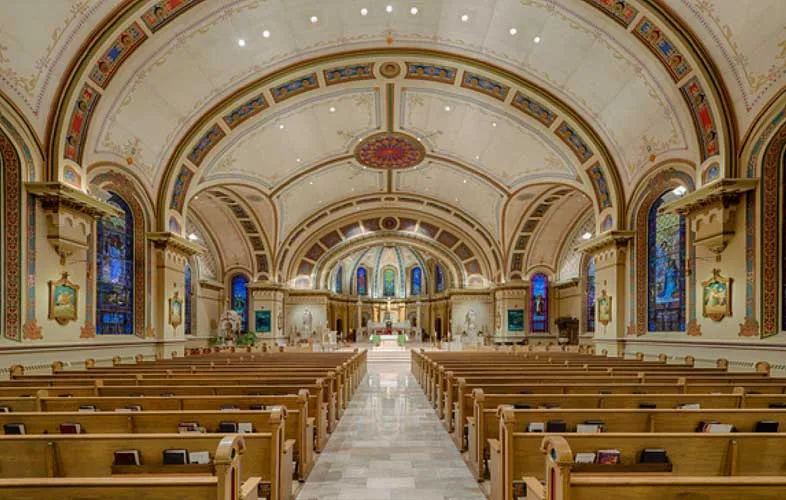
Cathedral of Saint John the Evangelist, Boise was designed by one of the first architectural firms to work in Boise, Tourtellotte & Hummel. Built in the Romanesque Revival style, the architects used the Cathedral of Mainz in western Germany and the Basilica of Saint-Sernin, Toulouse as their inspiration. The exterior is Boise Sandstone, quarried just above the city at Table Rock. The building is cruciform in shape and measures 170 feet (52 m) from front to back, 95 feet (29 m) at the transepts and 65 feet (20 m) in the nave.
The building was designed to have two towers topped with spires flanking the main façade, but they remain incomplete. A rose window graces the front of the church and the center gable above the main entrance features a statue of St. John the Evangelist on its peak. Corbeling, a continuous band of small projecting arches, encircles the building at the roofline. A fléche rises above the crossing.
The stained glass windows in the nave depict scenes from the life of Christ. The large window in the north transept depicts the Adoration of the Magi, flanked by windows portraying St. Alphonsus Ligouri and St. Theresa of Avila. The south transept window depicts the Ascension and is flanked by windows portraying St. Patrick and St. Rita. The windows in the sanctuary depict St. Joseph on the north and the Blessed Virgin Mary on the south. In the apse are windows portraying the Sacred Heart of Jesus and the Immaculate Heart of Mary.
They are flanked by windows portraying the Four Evangelists. Although some of the art glass was installed by the Inter mountain Glass Company of Boise, the stained glass windows were designed and installed by the John J. Kinsella Company of Chicago in 1920, except the window portraying the Holy Spirit in the center of the apse, which was installed in 1979. St. Cecilia is depicted in the window above the pipe organ.
The 3 manual, 2,900 pipe organ was installed by Tellers-Kent in 1921. At the time, composer Frederick Fleming Beale, professor of music at the College of Idaho, was organist and choir director.
The cathedral shines most brilliantly inside. It is here that the Romanesque style comes alive in a concert of colored light and ornamental elements of richly veined Italian marbles, tile work, gilded ornament, and wall paintings. With seating for 1,000 worshippers, St. John’s is one of the largest worship spaces in the state; its cruciform plan measures 170 feet long by 65 feet wide. The organ consists of 43 ranks, the equivalent to 3,000 pipes, which makes it one of the largest in Idaho. The barrel vaulted ceiling is structurally false and functions as an acoustic canvas to enhance the choir music.
St. John’s has beautiful stained glass windows depicting the life of Christ, the four gospel writers, and four saints. The figures are painted in a realistic style and were installed in one piece by the John Kinsella Glass Company of Chicago; this was innovative at the time because typically each color of stained glass would be installed separately. Additionally, the stained glass is thickly leaded and not common for the era.
Charles Hummel II, grandson of the architect, notes that, “what is remarkable are the painted parts are only reserved for faces and hands.” Furthermore, he explains that four saints depicted in the windows have particular significance to Boise: St. Rita represents the eponymous society that played an active cultural role in Boise at the time; St. Patrick pays tribute to the first Catholic Church in Boise; the first Catholic hospital in Idaho was named St. Alphonsus; and St. Theresa represents Boise’s first Catholic academy (now Bishop Kelly High School).
In response to the Vatican Council II reforms of the 1960s, a committee composed of Charles Hummel II, architect grandson of the original designer, Father Tom Faucher, a parish priest and liturgical expert, and Robert Rambusch, a New York specialist in church interiors, proposed a remodeling program to meet the new liturgical guidelines. The committee also proposed a thorough cleaning: because of the original coal furnace and candle chandeliers, a significant amount of soot covered the interior and exterior of the Cathedral.
With a budget of $351,423 renovations began on Easter Monday 1979 and were on a strict schedule to be completed six months later. The most visible change was in the lighting as the candle chandeliers were replaced by soft up lights on the cornices. Removing 50 years of soot from the decorated canvas ceiling revealed its original bright colors, and interior walls were painted a lighter color, brightening the entire space.
A key addition during the Vatican II remodeling is the Holy Spirit stained glass window in the center of the apse. Though part of the Cathedral’s initial design, the back of the main altar would have hidden the window so it was never installed. Added in 1979, modeled after a window in St. Peter’s Basilica in Rome and produced by the Rambusch Company, it is the only modern stained glass in the Cathedral.
The latest restoration of St. John’s commenced on the cathedral’s 100 years anniversary and focused primarily on landscaping and the basement, where the chapel and parish hall are located. The architects, Rob Thornton and Russ Philips, transformed the chapel into a 24 hours adoration chapel accessed separately from the cathedral. The remodel included new marble floors, pews, altar, and exposed the original sandstone walls.
After two renovations, St. John’s has retained its original style and use. Its intricate Romanesque architecture is so admired that there are weekly tours meet a curious public’s demand to know more about the building. Today, the state’s oldest firm, Hummel Architects, still displays the cathedral on its website as one of its proudest legacies.
Restoration and Remodel
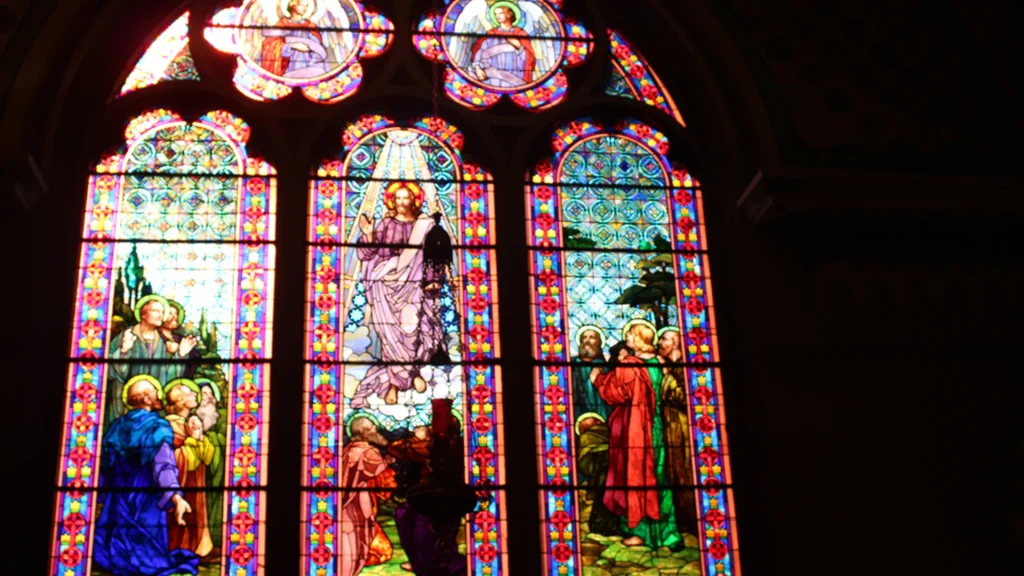
The interior of the Church had a major cleaning in 1952 and In 1960, another remodeling plan took place and the parish decided to continue to work with the Hummel family, hiring Charles Hummel’s grandson, who was named Charles after his grandfather. Charles Hummel Jr. also worked on the 1979 restoration, focusing on four main ideas.
He wanted to restore all the stained glass windows that illustrate the stories of the saints, create more seating for the different groups of people who would come to the cathedral for ceremonies, celebrations, and worship, renew the canvas accents and designs in the interior, and bring in tasteful modern lighting fixtures which accented the classic renaissance look but accommodated to the needs of the citizens. To accomplish such ideas, Hummel had to make some radical changes to the Cathedral’s interior. He also made sure important architectural details were not changed during the remodel.
These details include the decorative gargoyles that metaphorically hold the weight of the church on their backs as a punishment for their sins, and the windows he restored.
To celebrate the church’s centennial, Rob Thornton took on the job of remodeling the downstairs chapel. Not wanting to tread on the shoes of Hummel’s original artistry, Thornton worked with him on the project. He took the plaster off the walls to expose the stone beneath but kept a section of the wood paneling that Hummel added in 1979. Thornton also added a dome-shaped hole in the ceiling of the chapel.
Thornton not only worked on the chapel in the lower level but on the reception hall as well. He took out the brown carpeting, exposed the stone on the walls, and created more space. The baptismal font was redesigned as a pool and the former font was repurposed as an ambry to hold the holy oils. A reservation altar for the tabernacle was created in the south transept. The canopy was from the former high altar. St John’s received an Orchid Award in 1981 from the Idaho Historic Preservation Council for outstanding work in restoration.
Cathedral Restoration: Phase II
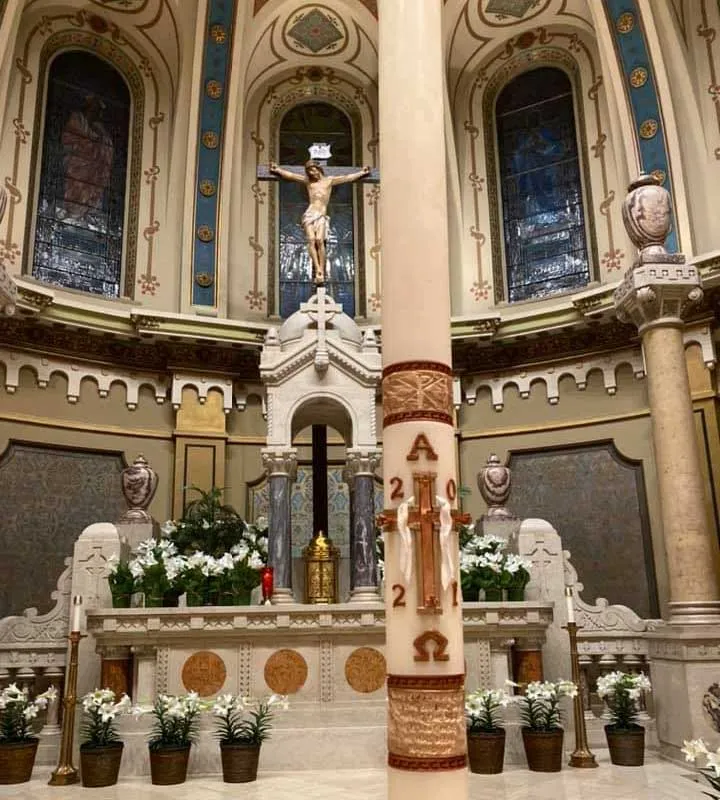
The Cathedral of St. John the Evangelist joined together with overwhelming response in phase one of the restoration of the Tabernacle to its original location of honor and prominence. The parishioners of St. John’s with tremendous generosity answered “YES” and were able to raise the needed $275,000 to complete the project in just six short weeks. The overwhelming desire for transcendence was evident, allowing Christ to be restored to the center of our Church and our lives once again.
The completion of this momentous historical moment at the Solemnity of Corpus Christi in June 2021, with an authentically Catholic festival and procession commemorating the 100th anniversary of the dedication of the Cathedral and restoration work completed. Soon after this, our pastor Bishop Peter Christensen gave his blessing to begin phase two of our restoration which includes:
- Restoring the Altar back into the Sanctuary space
- Adding pews to restore 100 seats needed for our growing parish
- Relocating the Ambo
- A new Holy Spirit window (that will better compliment the current colors and design of our beautiful windows)
- Needed restoration of the Sacred Heart and Catherine of Siena stained glass windows
- Removal of the current baptismal pool and restoring the exclusive use of the original marble baptismal font located adjacent to the St. Joseph statue.
Our Christian faith is the fusion of the transcendent and immanent, both informing our celebration of the Liturgy. Transcendence is beyond or above the ordinary; (of God) existing apart from and not subject to the limitations of the material universe. The immanent element of Christianity is God incarnate as the second person of the Trinity, and sharing in the human experience. Phase two will keep the liturgical focus on God, maintaining the transcendent character of worship, while still retaining the immanent gathering in human fellowship of Christ in our midst.
Feast Day – 27th December
The feast day of Saint John in the Catholic Church, Anglican Communion, and the Lutheran Calendar, is on 27 December, the third day of Christmastide. In the Tridentine Calendar he was commemorated also on each of the following days up to and including 3 January, the Octave of the 27 December feast.
Mass Time
Weekdays
Wednesdays
Saturdays
Sundays
Church Visiting Time
Contact Info
Cathedral of Saint John the Evangelist,
807 N 8th Street, Boise,
Idaho, ID 83702, United States
Phone No.
Tel : +1 208-342-3511
Accommodations
How to reach the Cathedral
Eckhart International Airport in Boise, Idaho is the nearby airport to the Cathedral.
Main Street Station in West Main Street, Boise, Idaho is the nearby train station to the Cathedral.





